Themed collection FOCUS: Recent progress on bioimaging technologies

Recent advances in activatable NIR-II organic fluorophores for biomedical applications
In this review, the molecular design and stimuli-responsive approach of activatable NIR-II organic fluorophores are introduced. Their applications in biomedical fields, ranging from biosensing to bioimaging and theranostics, are also highlighted.
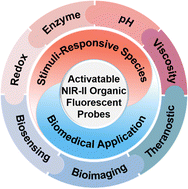
Mater. Chem. Front., 2023,7, 828-845
https://doi.org/10.1039/D2QM01120D
Activatable organic photoacoustic probes for in vivo anion imaging
This review gives focused attention on in vivo anion imaging based on activatable organic photoacoustic probes, with emphasis on imaging mechanisms at the molecular level, to inspire innovative ideas for future theranostics of diseases.

Mater. Chem. Front., 2023,7, 775-788
https://doi.org/10.1039/D2QM01207C
Photofunctional transition metal complexes as cellular probes, bioimaging reagents and phototherapeutics
This critical review summarises the recent biological applications of transition metal complexes as cellular probes, bioimaging reagents and phototherapeutics.

Inorg. Chem. Front., 2021,8, 4553-4579
https://doi.org/10.1039/D1QI00931A
AIE polymers in sensing, imaging and theranostic applications
This review summarizes the progress of AIE polymers in sensing, imaging and theranostic applications in the recent 3 years, and the perspective and future development of AIE polymers are discussed briefly.
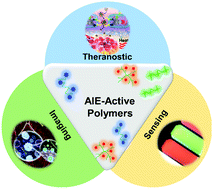
Mater. Chem. Front., 2021,5, 4073-4088
https://doi.org/10.1039/D1QM00078K
Recent progress in utilizing near-infrared J-aggregates for imaging and cancer therapy
Schematic diagram of NIR J-aggregates of various organic dyes as effective bioimaging (fluorescence (FL) or photoacoustic (PA)) and therapeutic agents (PDT or PTT).
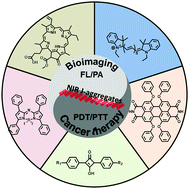
Mater. Chem. Front., 2021,5, 1076-1089
https://doi.org/10.1039/D0QM00557F
Wash-free detection and bioimaging by AIEgens
Herein, the latest progress of AIEgens for application in wash-free detection and bioimaging was reviewed.
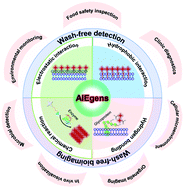
Mater. Chem. Front., 2021,5, 723-743
https://doi.org/10.1039/D0QM00586J
PVP-coated ultrasmall Nd-doped Gd2O2S nanoparticles for multimodal imaging
Versatile synthesis for all rare earth oxysulfides (RE2O2S) and evaluation of the potential of ultrasmall Gd0.8Nd1.2O2S as a multimodal contrast agent.

Mater. Chem. Front., 2023,7, 4109-4119
https://doi.org/10.1039/D3QM00554B
Rational design of amphiphilic BODIPY-based photosensitizers for multimodal imaging-guided phototherapy
Schematic illustration of the amphiphilic BODIPY-based photosensitizers for multimodal imaging-guided phototherapy through J-aggregation.

Mater. Chem. Front., 2023,7, 3668-3679
https://doi.org/10.1039/D3QM00239J
Multifunctional nanomicelles constructed via an aggregation and de-aggregation strategy for magnetic resonance/NIR II fluorescence imaging-guided type I photodynamic therapy
This work demonstrated that the aggregation and de-aggregation strategy of AIEgens in nanomicelles is very attractive for constructing multifunctional theranostic probes.

Mater. Chem. Front., 2023,7, 3657-3667
https://doi.org/10.1039/D3QM00347G
Glutathione depletion-mediated in situ transformation of Prussian blue nanocubes for enhanced tumor-specific imaging and photoimmunotherapy
This work provides a novel glutathione depletion-mediated in situ transformation strategy for enhanced tumor-specific imaging and photoimmunotherapy.

Inorg. Chem. Front., 2023,10, 4054-4064
https://doi.org/10.1039/D3QI00441D
Enhanced radioluminescence of NaLuF4:Eu3+ nanoscintillators by terbium sensitization for X-ray imaging
NaLuF4:Eu3+ nanoscintillator with enhanced radioluminescence was boosted by the sensitization effect of Tb3+ on Eu3+ with an excellent X-ray scintillation performance, and further applied in X-ray imaging with high contrast for different samples.

Inorg. Chem. Front., 2023,10, 3974-3982
https://doi.org/10.1039/D3QI00777D
Europium doped-double sodium bismuth molybdate nanoparticles as contrast agents for luminescence bioimaging and X-ray computed tomography
We have synthesized Eu-doped NaBi(MoO4)2 nanoparticles functionalized with PAA whose properties make them excellent multimodal contrast agents for X-ray computed tomography and luminescent bioimaging, as illustrated using a C. Elegans animal model.
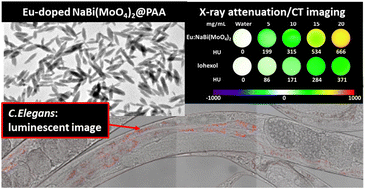
Inorg. Chem. Front., 2023,10, 3202-3212
https://doi.org/10.1039/D2QI02664C
Gadolinium-loaded LTL nanosized zeolite for efficient oxygen delivery and magnetic resonance imaging
The search for efficient gas carriers for biomedical applications presents a challenging task due to the kinetics of gas adsorption/desorption. This article presents a novel approach utilizing Gd-LTL zeolite crystals for oxygen delivery combined with an MRI study.

Inorg. Chem. Front., 2023,10, 2665-2676
https://doi.org/10.1039/D3QI00169E
Ligand engineering of luminescent AuAg nanoclusters for targeted mitochondrial and brain imaging
Surface engineering of highly luminescent AuAg nanoclusters via triphenylphosphine conjugation enables targeted mitochondrial and in vivo brain imaging.

Mater. Chem. Front., 2023,7, 1146-1152
https://doi.org/10.1039/D2QM01125E
Highly efficient and thermally stable broadband NIR phosphors by rationally bridging Cr3+–Yb3+ in LiScGe2O6 for optical bioimaging
A broadband NIR phosphor covering the 750–1200 nm region with high luminescence efficiency and good thermal stability was realized by the energy transfer of Cr3+ → Yb3+.
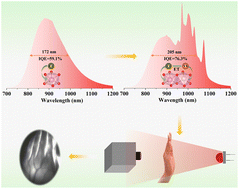
Inorg. Chem. Front., 2023,10, 860-868
https://doi.org/10.1039/D2QI02201J
AIEgens for dual second harmonic generation and fluorescence “turn-on” imaging of membrane and photodynamic therapy in cancer cells
The integration of second harmonic generation (SHG) microscopic imaging and aggregation-induced emission fluorescence imaging would greatly boost the imaging outcomes because of the combination of merits in each imaging modality.

Mater. Chem. Front., 2023,7, 502-513
https://doi.org/10.1039/D2QM01081J
Lipid droplet formation and dynamics: tracking by time-resolved fluorescence imaging
A highly biocompatible long-lived fluorescence micelle nanoprobe AI-Cz-M was constructed for tracking the formation and dynamics of lipid droplets in living tumor cells and adipocytes in real-time and quantitatively.

Mater. Chem. Front., 2022,6, 3691-3697
https://doi.org/10.1039/D2QM00965J
Photoactivatable tandem fluorescence imaging of organelles and their interplay monitoring
Most fluorescent probes can only be used for targeted imaging of single organelles, we herein develop a photoactivatable probe for tandem imaging of different organelles and in situ monitoring of their interplay with simple operation.

Mater. Chem. Front., 2022,6, 3662-3668
https://doi.org/10.1039/D2QM00907B
Harnessing solution and solid-state emissive materials from aliphatic biogenic amine-induced transient assembly and spontaneous disassembly
This work represents the harnessing of water-soluble emissive materials for bioimaging application via biogenic amine-induced transient assembly and disassembly.
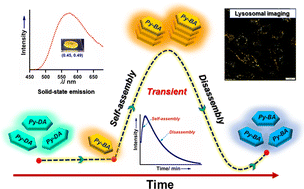
Mater. Chem. Front., 2022,6, 3489-3503
https://doi.org/10.1039/D2QM00861K
Highly symmetric Ln(III) boron-containing macrocycles as bright fluorophores for living cell imaging
Boron-assisted highly symmetric rigid Ln macrocycles were designed and synthesized, showing high brightness and promising potential applications in bioimaging.

Inorg. Chem. Front., 2022,9, 5048-5054
https://doi.org/10.1039/D2QI01476A
Simultaneous one-step regulation of planarization and donor rotation to enhance multi-modal imaging guided therapy
The one-step regulation of planarization and donor rotation provided a convenient method to design theranostic agents for elevating imaging and therapy simultaneously.

Mater. Chem. Front., 2022,6, 2921-2928
https://doi.org/10.1039/D2QM00568A
pH-Responsive nanoprobes for tumour fluorescence imaging based on spirolactam rhodamine
HA-RdB-EDS NPs possess excellent optical properties, anti-interference capability and lysosome-targeted ability. Significantly, HA-RdB-EDS NPs can turn on the fluorescence according to the lysosomal pH changes induced by Baf-A1 in HepG2 cells.

Mater. Chem. Front., 2022,6, 2869-2879
https://doi.org/10.1039/D2QM00406B
Studies of the hydrophobic interaction between a pyrene-containing dye and a tetra-aza macrocyclic gadolinium complex
An in vivo and an in vitro investigation of the hydrophobic interaction between HPTS and the gadolinium(III)-complex of tetra-aza macrocyclic ligand HP-DO3A (Gd(HP-DO3A)) are reported.
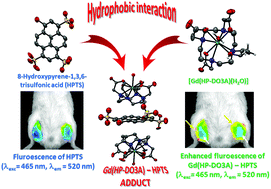
Inorg. Chem. Front., 2022,9, 3494-3504
https://doi.org/10.1039/D2QI00596D
Ultralong blue room-temperature phosphorescence by cycloalkyl engineering
An ultralong blue RTP effect with lifetime up to 1116.10 ms has been achieved by cycloalkyl modification of phenothiazine-5,5-dioxide.

Mater. Chem. Front., 2022,6, 1606-1614
https://doi.org/10.1039/D2QM00284A
Highly uniform Y3Al2Ga3O12-based nanophosphors for persistent luminescence bioimaging in the visible and NIR regions
A simple strategy is proposed to synthesize highly uniform garnet-based nanospheres that exhibit colloidal stability in physiological media, high biocompatibility and both green and NIR persistent luminescence.
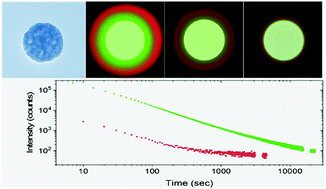
Inorg. Chem. Front., 2022,9, 2454-2461
https://doi.org/10.1039/D2QI00480A
A bioorthogonal assembly based on metallophilic interactions for selective imaging and PDT treatment of cancer cells
TC3 cations loaded on hyaluronic acid were selectively taken up by cancer cells. The following incubation with A5 or A10 anions led to the bioorthogonal self-assembly of C3–A5/A10 in cancer cells with luminescence and singlet oxygen turn-on.

Inorg. Chem. Front., 2022,9, 2290-2297
https://doi.org/10.1039/D2QI00147K
A brightly red emissive AIEgen and its antibody conjugated nanoparticles for cancer cell targeting imaging
Antibody decorated nanoparticles with brightly red emissions are promising probes for targeted detection of cancer cells due to their excellent specificity, deep penetration depth, high photostability and low phototoxicity.
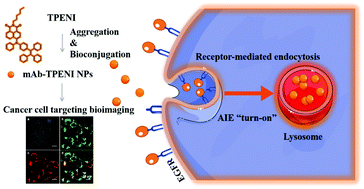
Mater. Chem. Front., 2022,6, 1317-1323
https://doi.org/10.1039/D2QM00273F
Two-dimensional BA2PbBr4-based wafer for X-rays imaging application
We successfully fabricated a pure phase 2D perovskite single crystal BA2PbBr4. We applied it as a wafer in the field of X-rays imaging and showed good imaging performance impressive environmental and temperature stability.
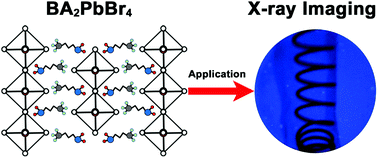
Mater. Chem. Front., 2022,6, 1310-1316
https://doi.org/10.1039/D2QM00233G
Molecular engineering of organic small-molecule photothermal agents by changing the donor group for photothermal therapy and photoacoustic imaging of tumors
A series of PTT agents based on ‘D–π–A’-type chromophores with different electron-donating groups were constructed to optimize their photothermal performance at 808 nm after nanogel loading.

Mater. Chem. Front., 2022,6, 1180-1187
https://doi.org/10.1039/D2QM00096B
A new cucurbit[10]uril-based AIE fluorescent supramolecular polymer for cellular imaging
The synthesis of the AIE fluorescent supramolecular polymer TPE-B@Q[10] is reported. This system exhibits excellent blue emission properties, good biocompatibility and was successfully employed for cytoplasmic imaging of cells.
![Graphical abstract: A new cucurbit[10]uril-based AIE fluorescent supramolecular polymer for cellular imaging](/en/Image/Get?imageInfo.ImageType=GA&imageInfo.ImageIdentifier.ManuscriptID=D2QM00084A&imageInfo.ImageIdentifier.Year=2022)
Mater. Chem. Front., 2022,6, 1021-1025
https://doi.org/10.1039/D2QM00084A
A cucurbit[6]uril-carbon dot system: a potentially new bioimaging agent
We report novel cucurbit[6]uril (Q[6])/carbon quantum dots (CQDs) prepared by solvothermal and nitrogen doped methods.
![Graphical abstract: A cucurbit[6]uril-carbon dot system: a potentially new bioimaging agent](/en/Image/Get?imageInfo.ImageType=GA&imageInfo.ImageIdentifier.ManuscriptID=D2QM00022A&imageInfo.ImageIdentifier.Year=2022)
Mater. Chem. Front., 2022,6, 973-980
https://doi.org/10.1039/D2QM00022A
Exceptionally fast formation of stable rigidified cross-bridged complexes formed with Cu(II) isotopes for molecular imaging
Cu(II) complexes formed with cross-bridged pentaazamacrocycle ligands exhibit high stability and appropriate inertness, as well as fast complex formation auguring a bright future for this ligand family in radiotheranostic applications.
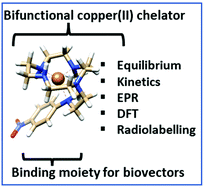
Inorg. Chem. Front., 2022,9, 1217-1223
https://doi.org/10.1039/D1QI01526E
Confined in situ polymerization in a nanoscale porphyrinic metal–organic framework for fluorescence imaging-guided synergistic phototherapy
This work provides a new type of nanoplatform of a metal–organic framework (MOF)-based hybrid material for fluorescence imaging-guided synergistic phototherapy.

Inorg. Chem. Front., 2022,9, 670-677
https://doi.org/10.1039/D1QI01384J
Synthesis and characterization of a stable and inert MnII-based ZnII responsive MRI probe for molecular imaging of glucose stimulated zinc secretion (GSZS)
A ZnII responsive MnII-based MRI contrast agent, [Mn(PC2A-DPA)], has been synthesized, investigated and applied in imaging studies. It shows high stability and excellent inertness and can be used to visualize glucose triggered ZnII release by MRI.
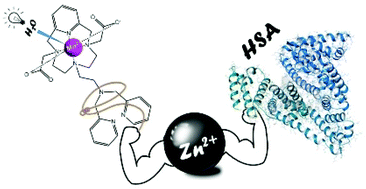
Inorg. Chem. Front., 2022,9, 577-583
https://doi.org/10.1039/D1QI00501D
Three birds with one stone: a single AIEgen for dual-organelle imaging, cell viability evaluation and photodynamic cancer cell ablation
We report the first single AIEgen that has great potential for dual-imaging of mitochondria/LDs, detection of cell viability and simultaneously photodynamic ablation of cancer cells.

Mater. Chem. Front., 2022,6, 333-340
https://doi.org/10.1039/D1QM01270C
A red-light-chargeable near infrared MgGeO3:Mn2+,Yb3+ persistent phosphor for bioimaging and optical information storage applications
An NIR-emitting MgGeO3:Mn2+,Yb3+ persistent phosphor chargeable with red light has been developed. The features of red-light charging and NIR persistent luminescence make this phosphor hold great potential for biomedical imaging and optical data storage.

Inorg. Chem. Front., 2021,8, 5149-5157
https://doi.org/10.1039/D1QI01158H
A biodegradable bismuth–gadolinium-based nano contrast agent for accurate identification and imaging of renal insufficiency in vivo
A biodegradable gadolinium-doped mesoporous bismuth-based nanomaterial is used to diagnose kidneys with dysfunction accurately via magnetic resonance imaging in vivo.

Inorg. Chem. Front., 2021,8, 4720-4729
https://doi.org/10.1039/D1QI00878A
Achieving metal-free phosphorescence in dilute solutions for imaging hypoxia in cells and tumors
Metal-free room temperature phosphorescence free of the constraint of a rigid environment was achieved by building selenium-based ICT systems. Hypoxia in cells and tumors can be imaged conveniently by molecules according to the proposed strategy.
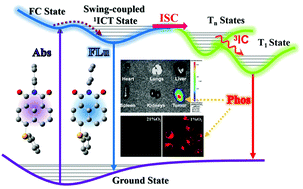
Mater. Chem. Front., 2021,5, 7170-7175
https://doi.org/10.1039/D1QM00733E
Rhenium carbonyl complexes bearing methylated triphenylphosphonium cations as antibody-free mitochondria trackers for X-ray fluorescence imaging
A convenient rhenium-based multimodal mitochondrial-targeted probe compatible with Synchrotron Radiation X-ray Fluorescence nano-imaging.

Inorg. Chem. Front., 2021,8, 3905-3915
https://doi.org/10.1039/D1QI00542A
Tumor microenvironment-activatable boolean logic supramolecular nanotheranostics based on a pillar[6]arene for tumor hypoxia imaging and multimodal synergistic therapy
Tumor microenvironment-triggered supramolecular nanosystems were fabricated, which showed excellent ability in cancer precision diagnosis and synergistic therapy.
![Graphical abstract: Tumor microenvironment-activatable boolean logic supramolecular nanotheranostics based on a pillar[6]arene for tumor hypoxia imaging and multimodal synergistic therapy](/en/Image/Get?imageInfo.ImageType=GA&imageInfo.ImageIdentifier.ManuscriptID=D1QM00411E&imageInfo.ImageIdentifier.Year=2021)
Mater. Chem. Front., 2021,5, 5846-5856
https://doi.org/10.1039/D1QM00411E
A DNA tetrahedron-loaded natural photosensitizer with aggregation-induced emission characteristics for boosting fluorescence imaging-guided photodynamic therapy
A natural AIE-active PS (PaH) is utilized to bind into DNA-T for cancer theranostics. The constructed PaH@DNA-T exhibits highly boosted fluorescence intensity and ROS generation, as well as much higher cell uptake efficiency.

Mater. Chem. Front., 2021,5, 5410-5417
https://doi.org/10.1039/D1QM00420D
A photoacoustic Zn2+ sensor based on a merocyanine/xanthene-6-ol hybrid chromophore and its ratiometric imaging in mice
HD-Zn was constructed for reversible ratiometric PA Zn2+ imaging in vivo. Zn2+ titration experiments together with a theoretical study suggests that Zn2+ chelation-induced ICT alteration in HD-Zn is responsible for its ratiometric PA sensing ability.
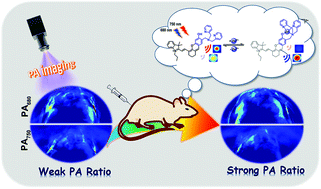
Inorg. Chem. Front., 2021,8, 3402-3410
https://doi.org/10.1039/D1QI00132A
Bright near-infrared α-tetraphenyletheneBODIPY nanoprobes with high aggregated state emission quantum yields in aqueous system for lipid droplet-specific imaging
Novel near-infrared lipid droplet-specific α-tetraphenyletheneBODIPY nanoprobes exhibited bright aggregated state quantum yields up to 0.81 in aqueous system and were applied for real-time bioimaging.

Mater. Chem. Front., 2021,5, 3664-3672
https://doi.org/10.1039/D1QM00067E
Design of polyazamacrocyclic Gd3+ theranostic agents combining magnetic resonance imaging and two-photon photodynamic therapy
New “all-in-one” theranostic systems, combining a magnetic resonance imaging contrast agent with a biphotonic photodynamic therapy photosensitiser generating cytotoxic singlet oxygen, were successfully developed and characterized.
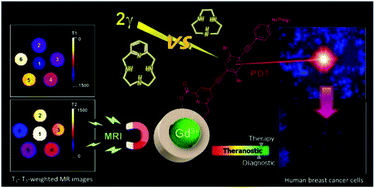
Inorg. Chem. Front., 2021,8, 2213-2224
https://doi.org/10.1039/D0QI01519A
Hydrogen peroxide-responsive AIE probe for imaging-guided organelle targeting and photodynamic cancer cell ablation
A versatile red/near-infrared AIE probe, TTPy-H2O2, was developed for the specific visualization of H2O2 with mitochondria targeting ability, meanwhile achieving efficient photodynamic therapy for cancer cells.
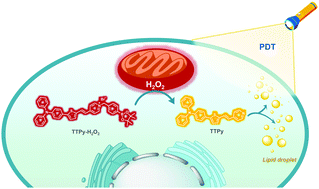
Mater. Chem. Front., 2021,5, 3489-3496
https://doi.org/10.1039/D1QM00328C
A near-infrared AIE probe for super-resolution imaging and nuclear lipid droplet dynamic study
A near-infrared AIE probe was developed for super-resolution imaging and nuclear lipid droplets dynamic study with good biocompatibility and high photostability.
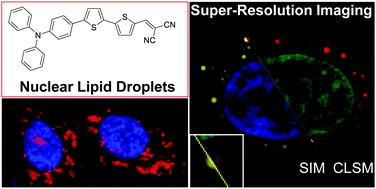
Mater. Chem. Front., 2021,5, 3043-3049
https://doi.org/10.1039/D0QM00914H
Rapid membrane-specific AIEgen featuring with wash-free imaging and sensitive light-excited killing of cells, bacteria, and fungi
C6-BD equipped with AIE and ESIPT characteristics was used to visualize the cell membrane with high selectivity, stability, and wash-free operation. It also universal for imaging of bacteria and fungi with light-excited killing via ROS generation.

Mater. Chem. Front., 2021,5, 2724-2729
https://doi.org/10.1039/D0QM01046D
Sensitive and specific detection of peroxynitrite and in vivo imaging of inflammation by a “simple” AIE bioprobe
A facile synthesized AIE bioprobe was developed to detect peroxynitrite sensitively and specifically. This bioprobe can realize both in vitro ONOO− detection and in vivo visualization of inflammation.
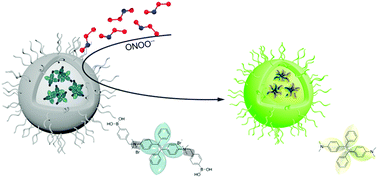
Mater. Chem. Front., 2021,5, 1830-1835
https://doi.org/10.1039/D0QM01004A
Biomarker-responsive nanoprobe with aggregation-induced emission for locating and guiding resection of deep-seated tumors via optoacoustic and NIR fluorescence imaging
A nanoprobe responsive to specific biomarkers with aggregation-induced emission has been developed for locating and guiding resection of tumors via optoacoustic and fluorescence imaging.

Mater. Chem. Front., 2021,5, 1962-1970
https://doi.org/10.1039/D0QM00904K
An easily synthesized AIE luminogen for lipid droplet-specific super-resolution imaging and two-photon imaging
A synergetic imaging platform was established to achieve LDs-specific imaging by STED nanoscopy and TPF microscopy. Benefiting from its high PLQYs, outstanding photo-stability, and high LDs specificity, a superior resolution in cells and a deep penetration depth in tissues were achieved.
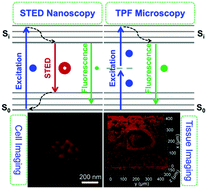
Mater. Chem. Front., 2021,5, 1872-1883
https://doi.org/10.1039/D0QM00682C
Supramolecular nanoparticles constructed from pillar[5]arene-based host–guest complexation with enhanced aggregation-induced emission for imaging-guided drug delivery
Supramolecular nanoparticles with enhanced aggregation-induced emission are prepared by taking advantage of pillar[5]arene-based host–guest complexation, and are sophisticated nanocarriers for imaging-guided drug delivery.
![Graphical abstract: Supramolecular nanoparticles constructed from pillar[5]arene-based host–guest complexation with enhanced aggregation-induced emission for imaging-guided drug delivery](/en/Image/Get?imageInfo.ImageType=GA&imageInfo.ImageIdentifier.ManuscriptID=D0QM00974A&imageInfo.ImageIdentifier.Year=2021)
Mater. Chem. Front., 2021,5, 1418-1427
https://doi.org/10.1039/D0QM00974A
Full-spectrum responsive WO3−x@HA nanotheranostics for NIR-II photoacoustic imaging-guided PTT/PDT/CDT synergistic therapy
A WO3−x-based nanotheranostic has been successfully fabricated for photoacoustic imaging-guided synergistic tumor targeting therapy in the second near-infrared (NIR-II) biological window.
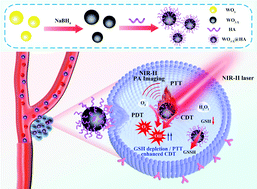
Inorg. Chem. Front., 2021,8, 636-646
https://doi.org/10.1039/D0QI01249A
A versatile synthetic approach to tunable dual-emissive Pdots with very small-size based on amphiphilic block copolymers for cell imaging
An effective strategy was constructed for the small-scale preparation of AIE-active Pdots, which displayed reversibly distinct dual-color fluorescence in cancer cells.

Mater. Chem. Front., 2021,5, 355-367
https://doi.org/10.1039/D0QM00497A
Small organic molecule-based nanoparticles with red/near-infrared aggregation-induced emission for bioimaging and PDT/PTT synergistic therapy
An organic small molecule T-BDP with D–A–D structure was designed and synthesized and could self-assemble into nanoparticles with significant AIE performance. Under 635 nm laser irradiation, T-BDP NPs ablate cancer cells through photodynamic/photothermal synergistic effects.
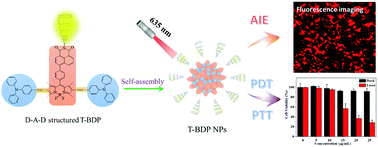
Mater. Chem. Front., 2021,5, 406-417
https://doi.org/10.1039/D0QM00536C
About this collection
Materials Chemistry Frontiers and Inorganic Chemistry Frontiers are delighted to introduce you the following collection of articles on “bioimaging technologies”. Articles featured in our focus collections are handpicked by Editors. We hope you find them enjoyable to read. Access is free till 22nd Sep.